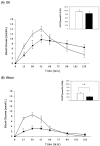Postprandial hypoglycemic effect of mulberry leaf in Goto-Kakizaki rats and counterpart control Wistar rats
- PMID: 20098579
- PMCID: PMC2809233
- DOI: 10.4162/nrp.2009.3.4.272
Postprandial hypoglycemic effect of mulberry leaf in Goto-Kakizaki rats and counterpart control Wistar rats
Abstract
Postprandial hypoglycemic effect of mulberry leaf (Morus alba L.) was compared in two animal models: Goto-Kakizaki (GK) rats, a spontaneous non-obese animal model for type II diabetes, and their counterpart control Wistar rats. First, the effect of a single oral administration of mulberry leaf aqueous extract (MLE) on postprandial glucose responses was determined using maltose or glucose as substrate. With maltose-loading, MLE reduced peak responses of blood glucose significantly in both GK and Wistar rats (P < 0.05), supporting the inhibition of alpha-glucosidase by MLE in the small intestine. With glucose-loading, MLE also significantly reduced blood glucose concentrations, measured at 30 min, in both animal models (P < 0.01), proposing the inhibition of glucose transport by MLE. Next, dried mulberry leaf powder (MLP) was administered for 8 weeks by inclusion in the diet. By MLP administration, fasting blood glucose was significantly reduced at weeks 4 and 5 (P < 0.05), but then returned to values that were similar to those of the control at the end of experimental period in GK rats. Insulin, HOMA-IR, C-reactive protein, and triglycerides tended to be decreased by MLP treatment in GK rats. All other biochemical parameters were not changed by MLP administration in GK rats. Collectively, these findings support that MLE has significant postprandial hypoglycemic effect in both non-obese diabetic and healthy animals, which may be beneficial as food supplement to manage postprandial blood glucose. Inhibitions of glucose transport as well as alpha-glucosidase in the small intestine were suggested as possible mechanisms related with the postprandial hypoglycemic effect of MLE.
Keywords: Aqueous mulberry leaf extract; Goto-Kakizaki rats; postprandial hypoglycemic effect.
Figures




Similar articles
-
Evaluation of hypoglycemic activity of total lignans from Fructus Arctii in the spontaneously diabetic Goto-Kakizaki rats.J Ethnopharmacol. 2014;151(1):548-55. doi: 10.1016/j.jep.2013.11.021. Epub 2013 Nov 21. J Ethnopharmacol. 2014. PMID: 24269245
-
Comparison of 1-deoxynojirimycin and aqueous mulberry leaf extract with emphasis on postprandial hypoglycemic effects: in vivo and in vitro studies.J Agric Food Chem. 2011 Apr 13;59(7):3014-9. doi: 10.1021/jf103463f. Epub 2011 Mar 3. J Agric Food Chem. 2011. PMID: 21370820
-
Mulberry leaf extract reduces postprandial hyperglycemia with few side effects by inhibiting α-glucosidase in normal rats.J Med Food. 2011 Jul-Aug;14(7-8):712-7. doi: 10.1089/jmf.2010.1368. Epub 2011 Jun 1. J Med Food. 2011. PMID: 21631361
-
Effects of Mulberry Leaf Fu Tea on the Intestines and Intestinal Flora of Goto-Kakizaki Type 2 Diabetic Rats.Foods. 2023 Nov 2;12(21):4006. doi: 10.3390/foods12214006. Foods. 2023. PMID: 37959125 Free PMC article.
-
Evaluation of mulberry leaves' hypoglycemic properties and hypoglycemic mechanisms.Front Pharmacol. 2023 Apr 6;14:1045309. doi: 10.3389/fphar.2023.1045309. eCollection 2023. Front Pharmacol. 2023. PMID: 37089923 Free PMC article. Review.
Cited by
-
Reduction of post-prandial hyperglycemia by mulberry tea in type-2 diabetes patients.Saudi J Biol Sci. 2015 Jan;22(1):32-6. doi: 10.1016/j.sjbs.2014.04.005. Epub 2014 May 23. Saudi J Biol Sci. 2015. PMID: 25561880 Free PMC article.
-
Animal models as tools to investigate antidiabetic and anti-inflammatory plants.Evid Based Complement Alternat Med. 2012;2012:142087. doi: 10.1155/2012/142087. Epub 2012 Jul 29. Evid Based Complement Alternat Med. 2012. PMID: 22899950 Free PMC article.
-
Antidiabetic Effects of the Ethanolic Root Extract of Uvaria chamae P. Beauv (Annonaceae) in Alloxan-Induced Diabetic Rats: A Potential Alternative Treatment for Diabetes Mellitus.Adv Pharmacol Sci. 2018 Nov 8;2018:1314941. doi: 10.1155/2018/1314941. eCollection 2018. Adv Pharmacol Sci. 2018. PMID: 30532775 Free PMC article.
-
Sargassum sagamianum Extract Alleviates Postprandial Hyperglycemia in Diabetic Mice.Prev Nutr Food Sci. 2018 Jun;23(2):122-126. doi: 10.3746/pnf.2018.23.2.122. Epub 2018 Jun 30. Prev Nutr Food Sci. 2018. PMID: 30018890 Free PMC article.
-
Taiwanese Green Propolis Ethanol Extract Delays the Progression of Type 2 Diabetes Mellitus in Rats Treated with Streptozotocin/High-Fat Diet.Nutrients. 2018 Apr 18;10(4):503. doi: 10.3390/nu10040503. Nutrients. 2018. PMID: 29670038 Free PMC article.
References
-
- Andallu B, Varadacharyulu NC. Antioxidant role of mulberry (Morus indica L. cv. Anantha) leaves in streptozotocin-diabetic rats. Clin Chim Acta. 2003;338:3–10. - PubMed
-
- Andallu B, Varadacharyulu NC. Gluconeogenic substrates and hepatic gluconeogenic enzymes in streptozotocin-diabetic rats: effect of mulberry (Morus indica L.) leaves. J Med Food. 2007;10:41–48. - PubMed
-
- Asano N, Yamashita T, Yasuda K, Ikeda K, Kameda Y, Kato A, Nash RJ, Lee HS, Ryu KS. Polyhydroxy alkaloids islated from mulberry trees (Morus alba L.) and silkworms (Bombyx mori L.) J Agric Food Chem. 2001;49:4208–4213. - PubMed
-
- Avignon A, Radauceanu A, Monnier L. Nonfasting plasma glucose is better marker of diabetic control than fasting plasma glucose in type 2 diabetes. Diabetes Care. 1997;20:1822–1826. - PubMed
-
- Chan JC, Malik V, Jia W, Kadowaki T, Yajnik CS, Yoon KH, Hu FB. Diabetes in Asia: epidemiology, risk factors, and pathophysiology. J Am Med Assoc. 2009;301:2129–2140. - PubMed
LinkOut - more resources
Full Text Sources
Other Literature Sources
Medical
Research Materials
Miscellaneous

